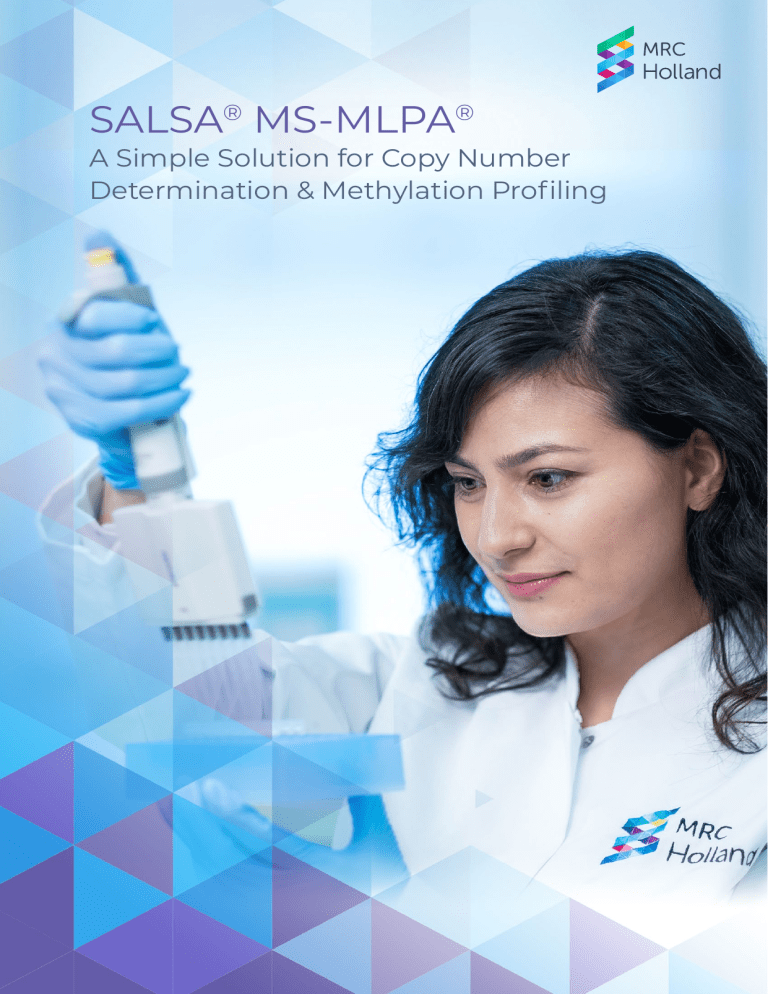
SALSA® MS-MLPA® A Simple Solution for Copy Number Determination & Methylation Profiling Methylation-Specific MLPA® Methylation-Specific (MS)-MLPA® is a variant of the MLPA technique, the gold standard in copy number determination. By combining the MLPA technique with the use of the methylation-sensitive endonuclease HhaI, it is possible to detect both DNA copy number and methylation status without bisulfite treatment. With MS-MLPA, semiquantitative methylation profiling of multiple targets is accomplished simultaneously and with ease. The Principle of MS-MLPA® MS-MLPA probes hybridise to their target sequences on the sample DNA. The MSMLPA reaction is split in two: an undigested reaction for copy number determination, and a digested reaction for methylation profiling. In the digested reaction, the HhaI enzyme is used to digest unmethylated double-stranded probe-DNA complexes. Complexes with methylated sample DNA are not digested by HhaI. Digested probes cannot be amplified exponentially, and therefore produce no signal, while non-digested probes generate a normal signal. Methylation is displayed as the percentage of the targeted DNA sequence that was methylated in the sample. MS-MLPA® Probemixes SALSA MLPA Probemix Application ME001 and ME002 Tumour suppressor mix 1 and 2 Methylation profiling for 25 tumour suppressor genes (TSG). ME011 Mismatch Repair Genes Mismatch repair genes methylation and associated Lynch syndrome genome changes profiling. ME012 MGMT-IDH1-IDH2 Targeted glioma profiling including MGMT methylation and IDH1/2 mutation detection. ME024 9p21 CDKN2A/2B region Cell cycle regulator profiling on 9p21 region associated with multiple tumour types including melanoma. ME028 Prader-Willi/Angelman Imprinting disorder profiling for Prader-Willi and Angelman syndromes. ME029 FMR1/AFF2 Fragile X syndrome associated promoter methylation profiling for male samples. ME030 BWS/RSS Imprinting disorder profiling for Beckwith-Wiedemann and Russell-Silver syndromes. ME031 GNAS Imprinting disorder profiling for Albright hereditary osteodystrophy and pseudohypoparathyroidism. ME032 UPD7-UPD14 Imprinting disorder profiling for UPD7, RSS, UPD14 (Temple & Kagami-Ogata syndromes). ME033 TNDM Imprinting disorder profiling for Transient Neonatal Diabetes Mellitus (TNDM). ME034 Multi-locus Imprinting Multi-locus imprinting disturbance profiling and to distinguish maternal and paternal triploidies. ME042 CIMP CpG Island Methylator Phenotype profiling (CIMP). MS-MLPA® probemixes are for Research Use Only. Not for use in diagnostic procedures unless explicitly stated otherwise. MS-MLPA® Application Highlight: Imprinting Disorders MS-MLPA® is frequently used to detect imprinting region methylation, like the PraderWilli/Angelman (ME028 PWS/AS) and Beckwith-Wiedemann/Russell-Silver (ME030 BWS/RSS) syndromes critical regions. These regions are known to have imprinting defects, such as those caused by uniparental disomy (UPD). MS-MLPA gives reliable results for both copy number and methylation status in the regions of interest. ME028 – PWS/AS Copy Number & Methylation Profiling ME028 contains over 40 probes targeting the Prader-Willi/Angelman critical region, covering SNRPN and MAGEL2 to establish DNA copy number. In addition, five dedicated methylation-sensitive probes enable methylation profiling of the region.+ Reference PWS Deletion PWS Imprinting Defect/UPD AS Deletion AS Imprinting Defect/UPD Digested reaction Methylation % Undigested reaction Probe ratio * probes sorted by genomic location ME030 – BWS/RSS Copy Number & Methylation Profiling ME030 contains over 40 probes that target the 11p15 Beckwith-Wiedemann/RussellSilver critical region that are used for copy number determination. Methylation status of the region is determined by eight methylation-sensitive probes that detect sequences in the H19DMR/IC1 and KvDMR/IC2 domains.+ Reference BWS IC1 Hypermethylation BWS pUPD11p15 BWS IC2 Hypomethylation RSS IC1 Hypomethylation Digested reaction Methylation % Undigested reaction Probe ratio * probes sorted by genomic location + Sample results must be compared to results obtained on DNA samples from unaffected individuals. * Images are an abridged representation of the target probe results for copy number and methylation profiling. T: target probe; H: target probe with an HhaI site; M: targeted methylation site SALSA® MS-MLPA® Protocol Copy Number Analysis + Ligase Methylation Analysis + Ligase & HhaI Denaturation Hybridisation Ligation & Digestion Amplification Fragment Separation Data Analysis 1. Sample DNA denaturation Sample DNA is heated to fully denature the DNA. 2. Hybridisation of probes to sample DNA SALSA MLPA Buffer and a SALSA MS-MLPA Probemix consisting of up to 60 probes are added to the sample. 3. Ligation & digestion of hybridised probes At this step, your reaction is split in two. In both tubes, hybridised probes are ligated by adding SALSA Ligase-65 enzyme and SALSA Ligase Buffers to form fully amplifiable probes. HhaI enzyme is added to one tube. This results in the digestion of non-methylated probe/allele hybrids. 4. PCR amplification of ligated probes Ligated complete probes are amplified by adding SALSA Polymerase and a single fluorescently-labelled primer pair. 5. Fragment separation by capillary electrophoresis MS-MLPA PCR products are loaded directly onto a capillary electrophoresis device. 6. Data analysis by Coffalyser.Net Coffalyser.Net: SALSA® MS-MLPA® Analysis Coffalyser.Net is free MLPA/MS-MLPA data analysis software designed and supported by MRC Holland. • • • • User-friendly software for reliable MLPA and MS-MLPA data analysis. Extensive quality control developed specifically for MLPA and MS-MLPA data. Immediate access to the latest analysis panels (Coffalyser sheets). Server-client model that allows data sharing. Willem Schoutenstraat 1 1057 DL Amsterdam the Netherlands tel +31 88 865 7200 info@mrcholland.com www.mrcholland.com GB-MS-A4-002D Confidence in Copy Number Determination


